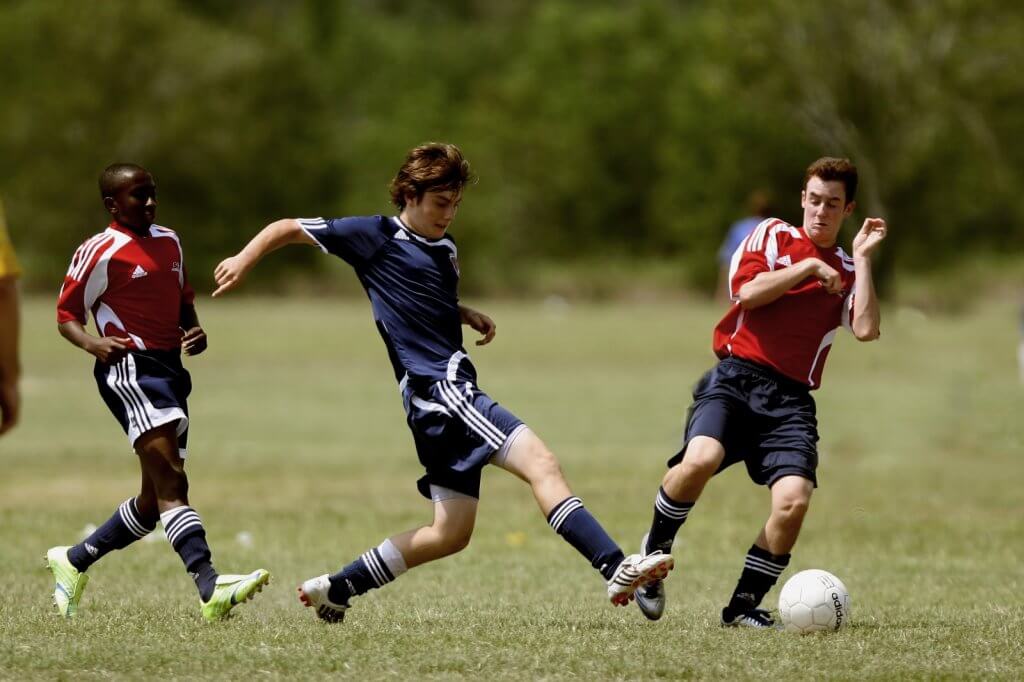5 Pre-Season Football Training Tactics to Adopt
With the excitement of the World Cup buzzing in this surprisingly, hot summer air, it’s time to scrub up your football skills and master the sport like a true pro. Learn how to physically and mentally prepare for those nine intense, yet exciting months of football with our quick guide.
We’ll take you through our top five football training tactics to improve your performance and get you pre-season ready.

1. Take A Break
Sadly for football fanatics, the beloved footie season only runs for eight to nine months. Those three months in between matches can leave players feeling lost. However, coaches will agree that this is the ultimate time for players to rest and recharge.
Though your mind and body might not feel as though it needs a cleanse, taking this time out to wind-down is crucial to ensure your muscles recover and mind to focus on the new season, rather than perhaps dwelling on the past.
For more professional football players, this break will often be rather short and still require them to do some physical activity to keep their fitness levels up. Even still, they’ll often indulge in some kind of rest period accompanied by light training, low intensity skill-practice and similar.
2. Create A Pre-Season Plan
Once you’ve had a few weeks’ or months’ break, you’ll want to start bringing the new season onto your agenda. The best way to ensure you make time for training and choose the most suitable training to slowly ease you back into the sport, is to create a pre-season plan.
It’s advised you start preparing 4-6 weeks beforehand depending on your commitment to the sport and skill level. It’s also good to theme each week with an area of focus. This way you can really monitor your progress – you’ll see your fitness and skills improve the closer you get to the new season’s kick off.
6-Week Simple Training Plan
Week 1
Do lots of cardio using a cross-trainer or treadmill and bodyweight strength training at the gym. Outside the gym, get back to mastering the football again. Focus on technical skills like first touches and passing.
Week 2
Continue upping your cardio and strength levels in the gym through running and bodyweight exercises like planks, pull-ups and similar. Plus increase football training to include more passing and intense 1 v 1 training.
Week 3
Start to incorporate weights in your gym sessions to improve your strength. Up the number of technical sessions you have with the football. You should start to make the sessions more cardio and life-like by incorporating running with the ball and using short bursts of high intensity sprints.
Week 4
Add some more core workouts to your gym routine to continue improving strength and agility. Practice shooting and playing in game situations as well as sticking to solo technical sessions.
Week 5
As your cardio is improving, focus attention to power moves including slam balls, squat jumps and similar. This will help build leg and arm muscles as well as giving you an intense, cardio-inducing exercise.
Week 6
Include some more “on your toes” exercises to your gym routine. This includes cone shuffles with the ball and other similar drills. Again, practise shooting and inter-circuit tactics that will help you be in complete control of the ball.
Good To Know: We recommend you have 4 rest days from the gym out of the 7 depending on how your body is taking to the increase in exercise. You should be practising your football skills on 5 out of the 7 days to keep you familiar with handling the ball.
For Coaches
If you’re a player looking to get your team back to their peak performance, you’ll first need to understand how you want them to play to base your training plan accordingly.
Most coaches will realise they must train athletes in order to carry out their tactical demands as well as technical and physical. So, you’ll want your plan to focus on these 3 core components. Once you’ve grasped what you’ll do to ensure each element is met, you’ll be ready to enter the pitch.
Tip: Coaches should also consider their previous season. Analyse not just your players and coaches but competitors and their tactics too. Find ways that’ll work for your team to counteract competitor play and give you an advantage.
Coaches usually find planning takes a lot longer and in some cases it’s deemed a harder job. It’s not just tactical, technical and physical elements you need to consider but then be able to merge these together as well as managing the team and keeping up morale and mental stability before matches.
Taking 6-8 weeks to prepare can ensure you’re giving yourself and the team the best chance to be ready for the new season.

3. Low Intensity Workouts
It’s important that you don’t dive back into intense workout routines particularly if you’ve spent the past few months relaxing and keeping your physical activity to a minimal.
Begin by going for jogs or try spinning or cycling. These activities will help you to start building your physical fitness up again without putting too much strain on your body. You can also branch out into tennis to help build both your upper body strength as well as practising your speed and agility skills.
The German approach to use lots of low-level endurance running proves to be very effective in maintaining cardiovascular fitness. – FourFourTwo
Of course, oppositely there will be players who react better to shorter, high intensity training routines. These are often then repeated regularly.
Different approaches will suit different players are different times. – FourFourTwo
Fitness Tactics That Work
If you’ve been in the football community for a long time, you’ll have some knowledge of what does and doesn’t work when it comes to pre-season training tactics. A popular method that continues to bring players success is the combination of endurance and interval training.
Endurance Training
As previously mentioned, going for runs are a highly popular choice for endurance training. Generally speaking, these runs should last around 20-30 minutes and be at an intensity that allows the athlete to hold a conversation.
Completing around three runs over the course of two weeks is deemed to derive the best results for the average player.
Interval Training
On the other hand, interval training such as quick sprints are also a great pre-season training drill. Completing a quick sprint should usually take around 15-17 seconds to finish and then 30 second rests should be allowed before going again. This will challenge your recovery mechanisms and ensure you’re ready to react quickly to any intense play by the opposition, without being lost for pace.
Good To Know: The above interval training shows a 1:2 work to rest ratio.
You can also complete some of the following high-intensity exercises to boost your fitness levels:
- Kettlebell swings or, for those not using weights, squats
- Reverse lunges
- Mountain climbers
- Burpees
In the case of pre-season training, when completing exercises that require weighted equipment, it’s important to start off by using light weights or in some cases, none at all. This will help you to gradually get back into the swing of things. For more information on this, see here.
4. Stretch – A Lot
After completing your workout, it’s important that you keep your body supple by stretching. This is a football training tactic that’s adopted during rest periods between seasons as well as throughout the season.
Why Stretch?
Stretching is a crucial aspect to any sport, not only football. Although some players, particularly those of a lower-level, are seen to often dismiss stretching and opt for more intense workouts, it’s a vital aspect to ensuring you’re on top form for matches.
Here’s why:
- It helps to reduce stress by relaxing your muscles
- It can reduce pain and stiffness which, in the long run, can reduce severity of muscle cramps – a footballer’s worst nightmare
- Improve health through reduced blood pressure, heart rate and breathing rate through reduced stress and muscle tension
- Increase the range of movement of major joints to ensure players can lunge, run and react quickly with limiting their chances of pulling a muscle or similar
- Reduce the risk of injury by performing dynamic stretches to slowly increase body temperature to prepare muscles for physical activity
Some great examples of stretches you should be regularly doing can be found here.
5. Pre-Season Friendlies
The whole point of pre-season friendlies is to get an idea of the players you’ll come up against whilst gradually easing yourself into the game.
Instead of competing in an intense match straight away, players can start to play competitively again without the need to exhaust their bodies straight away. In turn, this can reduce chance of muscle injury and similar.
If players perform well and get a couple of wins under their belt, it can also boost morale and put them in a good position mentally. Even if the team loses, it will give them tactical familiarity which will give them an advantage going into the first match.
Tip: It’s advised that you allow for player rotation in these matches to ensure most players get a chance to take to the field and improve their condition and fitness prior to the official game.
Sara Whitehouse, SEO and Content Editor at Stadia Sports
Stadia Sports are a leading UK manufacturer and sports equipment suppliers, offering a wide range of products including football goals, football nets and accessories.